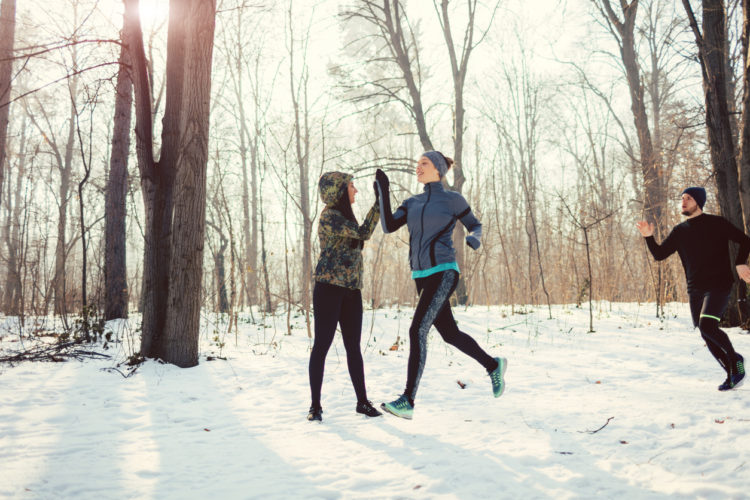By STACEY PENNEY, MS, NASM-CPT, CES, PES, FNS
Exercising in the cold can bring about many unique challenges. Besides overcoming the discomfort of being cold, what are the best strategies to stay safe and prevent some of the potentially life-threatening, or at least performance reducing, challenges?
Layered
One of the easiest strategies to counter the cold weather is to have the right gear for the exercise environment. Dressing in layers is one of the best defenses against the cold. Choosing moisture wicking fabrics to keep your skin dry from sweat will keep you warm since water is a very poor insulator (1). Outer layers can be removed to release built up body heat as exercise intensity increases or becomes wet from the elements. Skin that is not covered will quickly lose heat (1,2). Wearing a hat or helmet will reduce your heat loss even further (1).
Hypothermia
One of the challenging and potentially life-threatening issues of exercising in the cold is the risk of hypothermia. Hypothermia occurs when the body’s heat loss exceeds its heat production and the core temperature drops below 95o F (35o C) (1,2). It can range from mild to severe, and can be affected by environmental (e.g., temperature, wind chill, water immersion) and insulating factors (e.g., clothing, body fat) (1,2). Additionally, certain characteristics of the exerciser can increase the risk of cold injury, including older age, lean body composition (less insulation), female, and a lower fitness level (1,2). Some of the signs and symptoms of hypothermia include shivering, lack of coordination, mumbling or trouble speaking, fatigue, and confusion (2,3). Prevention strategies include limiting prolonged exposure to cold, wet, or windy conditions (2).
Frostbite
Frostbite, another cold exposure injury to be aware of, occurs when the skin and the tissue underneath it freezes. Frostbite may even be accompanied by hypothermia. Areas most prone to frostbite include the hands, feet, nose, and ears, but it can affect any part of the body (4). Some of the signs and symptoms of frostbite include a feeling of pins and needles followed by numbness, skin that’s hard, pale, and cold, a lack of sensation in the area, or an ache or throb (2,4). Prevention strategies include keeping the skin warm and dry (4,5). (For more info on environmental cold injuries and risk management, view the NATA position statement.)
Exercise-Induced Asthma (EIA)
EIA may affect as many as 50% of winter sport athletes, in both indoor and outdoor sports (6). Most of these athletes do not have “regular” asthma. EIA is also known as Exercise Induced Bronchoconstriction (EIB) (2). The cause of EIA for these winter sports athletes has been linked to the low humidity level of the cold air they are breathing and their high respiration rate (2,6). This leads to the airway drying out and constricting, causing symptoms such as shortness of breath, wheezing, coughing, and decreased performance.
Prevention strategies for EIA include activity warm-ups that last for at least 10 to 15 minutes with gradually increasing intensity. Breathing through the nose versus the mouth will also help to warm and humidify the air entering the throat and lungs. Oral and inhaled medications are also available, but if competing be aware that many of the medications are regulated be anti-doping agencies (6). Staying well hydrated is also key for replenishing fluids lost during respiration (7).
Strains and Sprains
When the body is cold, it reduces blood flow to the extremities (vasoconstriction) in an effort to keep the core warm. Shivering, another of the body’s mechanisms for staying warm, causes an on and off tensing of the muscles. Neither of these cold reactions will improve the muscles or connective tissues’ ability to react to the demands placed on it to perform (5,8). Prevention strategies include spending ample time in warm-up activities and taking warming breaks (5).
Play it Safe
Exercising in the cold, especially outdoors, requires some planning and responsibility. This includes reviewing the weather forecast and terrain conditions, partnering up, keeping hydrated and energized, using safety gear, following the rules, along with knowing when it is time to stop and get out of the cold (5).

